Dial H for Hero:Reboots and Reimaginings
Hello! If you’re reading this, you’ve found the section of my website where I write for a different project for a class I took at the same time as Z681. The following post was written for Z604: Comic Books and Their Readers.
I’m drawn to stories of commercial failure. One of my favorite genres of Youtube videos are essays analyzing the ‘rise and fall’ of something or other, especially if I have no knowledge of the topic beforehand. I love all kinds of failures, from the tales of corporate hubris and mismanagement to the hidden gems that were released to an uncaring public who wasn’t ready for them yet. This added to my intrigue upon discovering that one of my favorite novelists, China Miéville had not only written a comic book series (I don’t read many comics, but I was looking for something to read for this project), but that it was swiftly canceled within a year of its publication. As it turns out, the work he had written was a gritty reboot of a much lighter toned 60’s series, and was followed by another adaptation in 2019. In this blog post, I’ll be exploring the original Dial H for Hero, the ill-fated 2012 reboot, and the most recent reboot from 2019. Through these three runs, I want to look at some of the ways in which reboots approach their source material, particularly when the source material is very dated in its content and style, and how new writers modernize the subject matter for new audiences. In the case of the original and 2012 runs, I’ll also take you through their sales data and try to find out what went wrong.
Before looking at the individual runs, I should first establish the central conceit of Dial H for Hero: that there exist fantastical machines shaped like rotary telephone dials. Dialing the letters “H-E-R-O” allows the dialer to temporarily transform into a random superhero, each with their own unique name and series of powers. (Readers my age may be reminded of Ben 10 a cartoon franchise with a similar premise). From there, the respective series all go in different directions in terms of how the dial works and how the world is built around it.
The Original Dial H for Hero
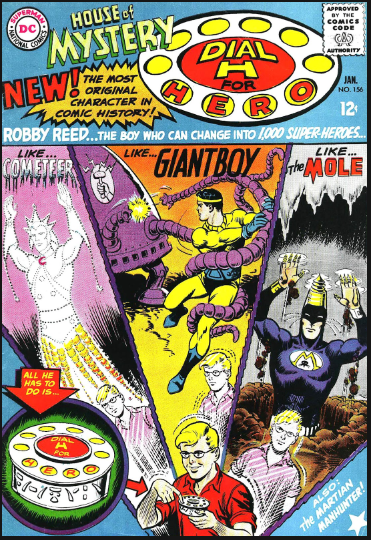
House of Mystery #156
The original Dial H for Hero was written by Dave Wood and illustrated by Jim Mooney, and ran as the headliner comic in the anthology series House of Mystery from January 1966 to April of 1968. Its hero was Robby Reed, a boy genius who, upon finding the dial, begins investigating around his hometown of Littleville, thwarting supervillains and petty crooks alike using the powers of the dial to transform into various heroes. Dialing “O-R-E-H” reverses the transformation, and the dial takes some time to be used again afterwards. Each issue featured three new heroes, with a few popular ones returning and even a cameo appearance from the already existing Plastic Man. The series was almost entirely episodic, with little continuity between issues. Even the mechanism of the dial needed to be explained every single issue, so it was likely assumed that readers would read the comics out of order or occasionally skip issues. Given this episodic format, the comic quickly falls into a familiar ‘monster of the week’ structure, each story ending with Robby successfully turning the villains in to the police.
I mostly enjoyed my time reading Dial H for Hero, though I don’t think I would have done so had I not already committed to reading it for a class. It feels a bit overly critical to impose current storytelling standards upon something that was made for audiences of nearly 70 years ago, so I won’t waste any time here criticizing its lack of subversiveness, nearly exclusively male cast, and repetitive structure. I do wish that there was real continuity between stories though. In one standout story, Robby’s classmate and crush Suzy catches him dialing and blackmails him into giving her a chance to use it. Unfortunately, at the end of the comic she’s hit her head and forgotten everything that just happened, returning to the status quo. Some more tension between Robby’s family and friends who he’s constantly slipping away from in order to become a superhero would also be interesting (I remember the first season of Invincible tackling this quite well, if you were looking for suggestions). I also felt that Robby as a character was not very compelling. He’s smart, he lives with his grandfather, and he has a crush on Suzy…and that’s about it. In lieu of any focus on Robby as a character, however, the thing most of the pages are dedicated to is Robby strategizing. With each new hero he has to quickly figure out the best way to use his new abilities to best defeat whatever villain is threatening him this month, and I did find this fun to read. Given the random nature of the dial, the heroes he gets are almost never perfectly optimal for the job, and so Robby’s creative problem-solving does a lot of the legwork in making each story feel compelling.
Regarding the ending of this run, I could not find a single piece of writing about its cancellation. It seems that Dial H for Hero was canceled unceremoniously, and the comic’s readers were not even warned when they’d reached the final issue. The last issue, #173, has no indication of being the last Dial story, and the regular fan letter column, Dial L for Letters, ends by instructing where to mail more fan letters. Of course, no more letters for this run are ever published. I pity the young fans who returned to the newsstands a month later and were disappointed to find a new headliner running in House of Mystery.
Dial H
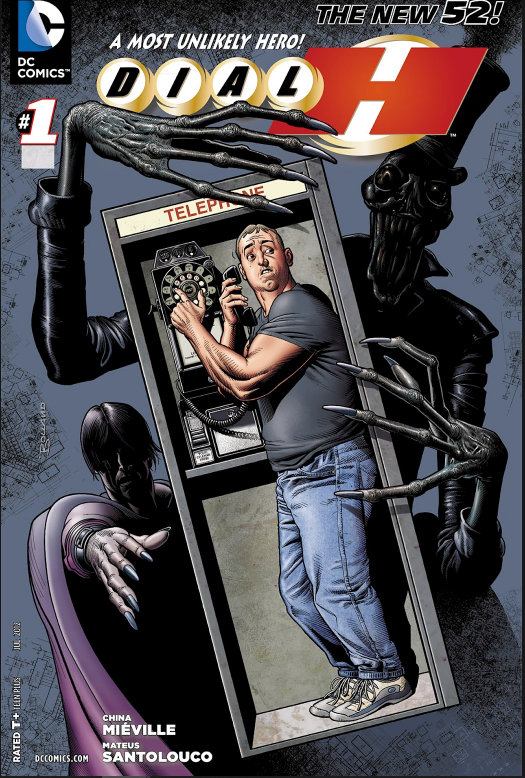
Dial H Issue #1
Dial H was part of DC Comics’ “New 52” project, in which all of their comics were completely rebooted, starting in late 2011. I’ll get into the financial failure of New 52 later on, but what’s important to know now is that DC was doing everything in their power to debut new, fresh, exciting material. It was this openness to new ideas that led to China Miéville being given the opportunity to write a serialized comic for DC. In an interview with him prior to Dial H’s launch, Miéville, a fan of Dial H for Hero since his early childhood, expressed a lot of excitement to write a new story with the dial, saying “The idea to basically come up with new crazy superheroes every month is intoxicatingly delightful for me” (Kotaku). Miéville, already an acclaimed fantasy novelist at this point, had only ever written a single issue of a comic book before. Though cagey about the details in this pre-release interview, Miéville promised to explore the psychological ramifications of constantly changing one’s physical form and identity with the turn of a dial.
Miéville immediately makes good on his promise to create a more grounded story, even with the fantastical premise. Dial H opens by introducing us to our hero Nelson Jent being dragged by his friend back to his apartment after suffering a heart attack. On top of that, he recently lost his job and his girlfriend left him. Depressed and out of shape, Nelson does not fit the typical image of a superhero. Regardless, it is he who accidentally discovers the H-dial while trying to call the police after seeing his friend get attacked. Upon dialing, Nelson gains not just a temporary new form (this time, the powers of the dial wear off on their own after a few hours) but also a new name and new memories. In a monologue in issue #2, Nelson says “My head’s full of smoke and mixed-up memories. When I dial, I lose track of who I am”(Dial H#2). Using the dial quickly becomes intoxicating to Nelson, as it allows him to become a new person in a body he doesn’t hate. However, he becomes haunted by the memories that come with all of these new identities. Identity, specifically maintaining one’s own identity in the face of the dial, is a central conflict that Nelson deals with throughout Dial H. We’re soon introduced to another dial user, always clad in a mask and robe. It’s revealed that she is Roxie Hodder, an elderly woman with decades of experience dialing who wears the same disguise with every transformation to maintain a personal sense of identity. Later on, I’ll talk a bit about how the characters of Dial H handle the heroes when they become something particularly objectionable.
For now, though, I’ll keep focused on the plot of Dial H itself. While Nelson and Roxie and their relationship are compelling and very well handled, I was disappointed to find the overarching plot of Dial H lackluster. To put it in short, there are other mysterious parties looking to get their hands on the power of the dial. These groups are organized criminals, shady government organizations, and even some cosmic-horror-Lovecraftian space monsters. The fights were difficult to follow and the color pallets were often drab and unappealing. In the latter half of the comic, new characters and locations are introduced too fast for the reader to wrap their head around what’s going on, and the whole thing ends with the surviving characters vowing to continue working with dials as they have been. Perhaps given some more breathing room Dial H might have flourished, but its cancellation was announced just a year after it debuted and loose ends needed to be tied as quickly as they could in the few months remaining.
The little fan reception I could find for Dial H was mostly people lamenting its early demise long after the fact. However, there were clearly not enough fans buying monthly issues to keep it running.One blog post written by a disgruntled former reader sums up what went wrong very well, in my opinion. He writes before the series’ cancellation announcement and is complaining about the cliche’d evil government agency being used yet again as the main villain. ‘Dave’ writes:
“Who is [Dial H] for exactly? Presumably, some comics are kept conventional for sales purposes–because more people are going to buy a Superman comic where he fights aliens than one of him doing nothing but taking a shower and thinking. But who is buying Dial H based on the name of the book? Who walks blind into a comic shop and instinctively seeks out this title? The only way a book like Dial H can succeed is through elevated critical acclaim and a subsequent torrent of word of mouth praise.”
I’ll leave the opinion of whether the comic’s story is too ‘conventional’ or not to the people who read more comics than I do. After all, I can’t be expected to everything that was coming out in the early 10’s to tell you if its tropes were overused or not. Unfortunately, all I can say is that with some exceptions (one of which I will write about in greater detail later in this blog) there is little to write home about.
Dial H for Hero (2019)
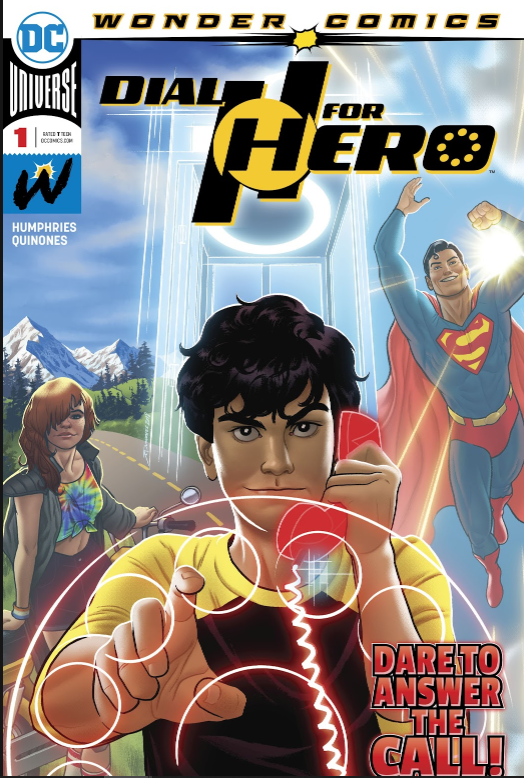
Dial H for Hero Issue #1
Dial H for Hero (2019) exceeded all my expectations, recycling an old and neglected IP to create a loving homage to superheroes and the people who admire them. By far my favorite of the three runs I read, Dial is a fun and accessible limited series that I feel confident in recommending to anyone.
Announced as one of the first wave of comics to be released under DC Comics’ new YA imprint Wonder Comics in 2019, Dial H for Hero (2019) promised to be a fun, fresh take on the silver age comic of the same name, drawing inspiration from comic book art styles across decades and countries. It was written by Sam Humphries and drawn by Joe Quinones.
Returning to teen protagonists, Dial stars Miguel Montez, a daredevil who idolizes Superman after being saved by him years before, and Summer Pickens, a runaway. When a stunt goes wrong and Miguel finds himself falling off a cliff, an old red rotary phone materializes in front of him, with a mysterious ‘Operator’ urging him to dial. When he does, he transforms into Monster Truck, an old-school styled hero with an art style change to go along with it. Once he comes to, he realizes he’s destroyed a used car lot and escapes with Summer, who’s stolen his uncle’s food truck. While the two are on the road, they start being hunted down by various seemingly random people. We learn that in this world, multiple people have used the dial and would do anything to get a chance to use it again, all urged by a “Mister Thunderbolt” on the phone to steal the dial back. I don’t want to spoil the story, so I’ll move on to discussing its art and writing style.
“Fun” is truly be best way to describe the writing, art style, and even page compositions of Dial H for Hero(2019). Every single issue is filled with loving homages to other comics, from beloved DC heroes and beyond. Almost every new dialed hero is drawn in a completely different style from the last, and many of these styles were even identifiable to me as a layperson. In this panel, for example, Miguel’s hero is clearly a reference to sunday paper comics such as The Family Circus.
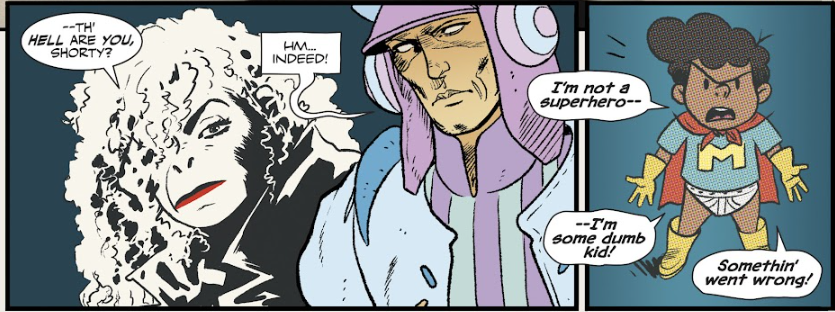
Dial H for Hero(2019), Issue #4, pg 13
In addition to playing with different art styles, Dial H for Hero (2019) also occasionally uses wacky layouts and and other nods to the physicality of comic books (though I read it online, unfortunately). Issue #8 is standout in this regard. It tells the backstories of (spoiler alert!) the Operator and Mister Thunderbolt, sworn enemies who turn out to be the same person--Robby Reed, after having split his consciousness in half. Issue #8 tells this story ingeniously, telling the Operator’s story forward chronologically and Thunderbolt’s backwards, until they converge on the last page.
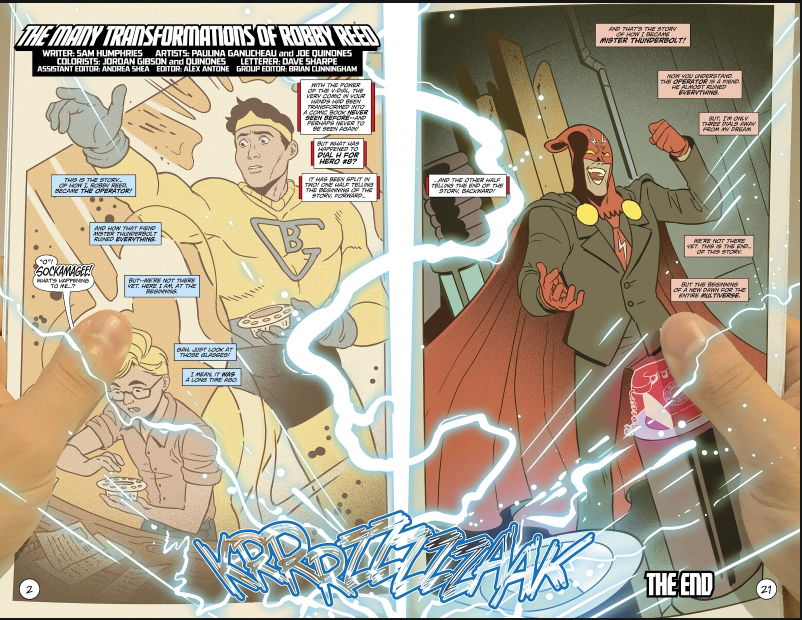
Issue #8, pg 4
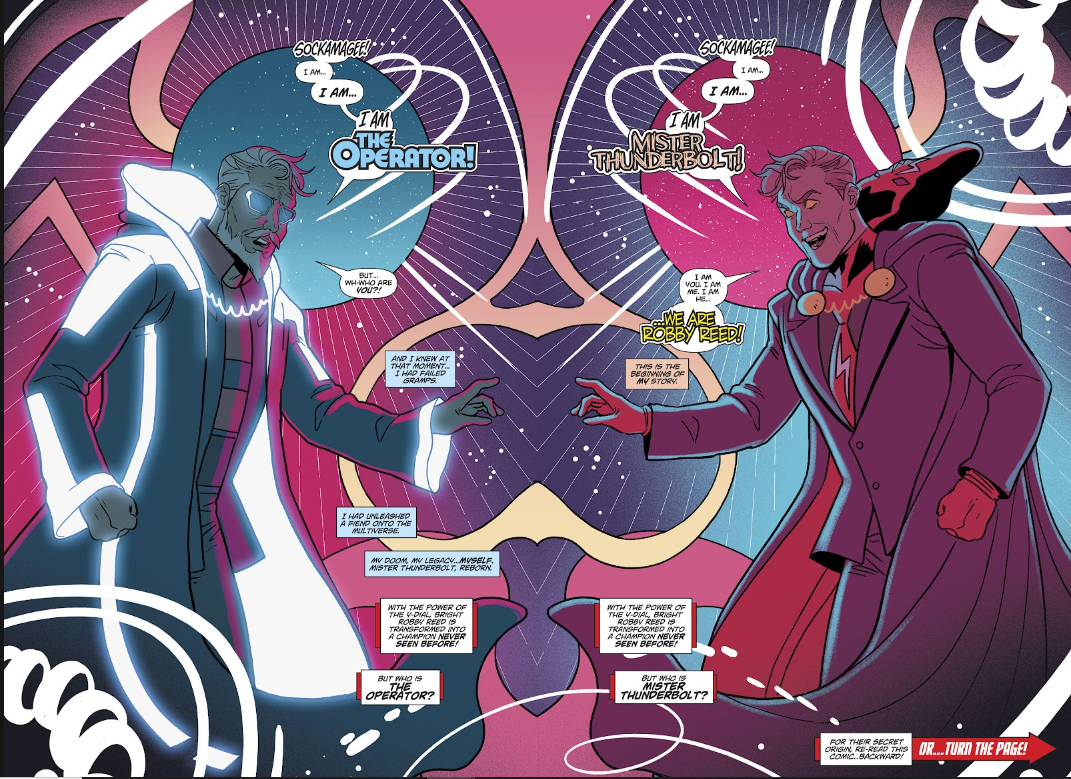
Issue #8, pg 21
Later, to illustrate this same point, a page meant to be folded in half to combine the portraits of the two men into one is included. On one page, there’s even a tongue-in-cheek invitation for the reader to cut out a page and fold it into a dial for themselves.
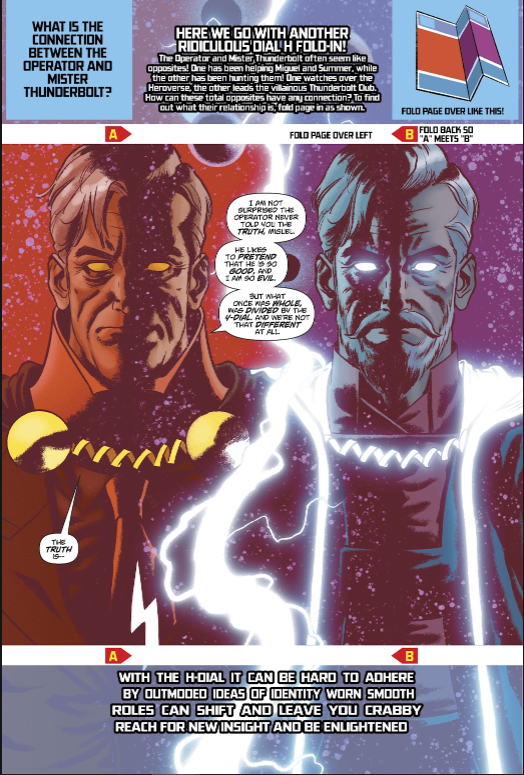
Issue #10, pg 15
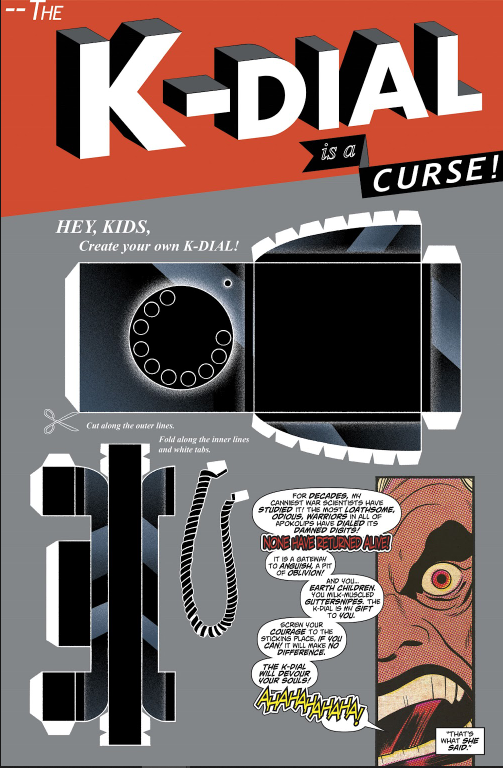
Issue #11, pg 8
Dial H for Hero (2019)’s obsession with the physicality of comic books goes even further, leeching into the plot itself. In this run, there are four different dials with slightly different effects upon use. They’re nicknamed the C, Y, M, and K dials respectively. CYMK is the ink format most typically used in printing comics, mixing the colors cyan, yellow, magenta, and black to achieve a range of shades.
Overall, the style of the 2019 reboot does a lot of the legwork in making the comic feel like a true homage to all that came before it. I do enjoy its story, but the art was by far its greatest strength.
Dial H in conversation with Dial H for Hero
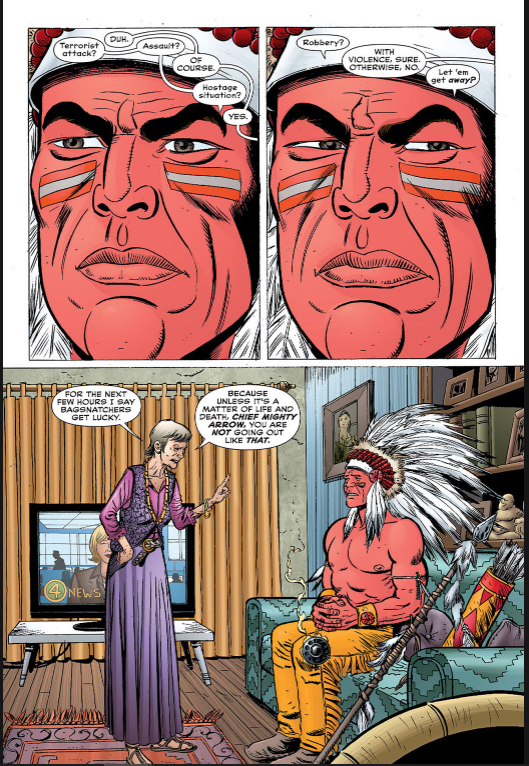
Dial H Issue #6, pg 1
The racist caricature of a Native American man slaps us right in the face with the opening of Dial H's sixth issue. An argument follows, with Roxie telling Nelson that as “Chief Mighty Arrow”, he would be doing more harm than good to go out in the open acting like some western writer’s conception of what a Native American person looks and acts like. His powers are all stereotypes. Additionally, because dialers in this comic take on aspects of the personality of the hero, Nelson also catches himself speaking like this kind of character would, saying “I’m heap big trouble for criminals” before Roxie interrupts him, saying “”Heap big?” Oh my god, can you hear yourself!?” She goes on to explain that in her many years of experience with the dial, she occasionally comes across a hero like this, something so offensive that she would never in good conscience be seen as them. I actually read this run first in my research, so I was shocked to come across the very same hero in issue #166 of House of Mystery.
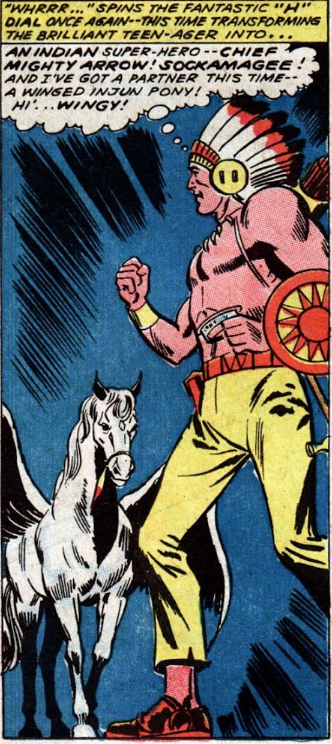
House of Mystery issue #166, pg 15
As one might expect from a piece written in 1967, ‘Chief Mighty Arrow’ is played completely straight here. Just as in the reboot, he’s equipped with a feathered headress, a bow and arrows, and a “winged injun pony!”. The hero was evidently popular, as he returned a few months later in another issue.
With the added context that Dial H is directly responding to its predecessor, we can see Miéville taking a stance against DC Comics’ racism of the past. There are very little references to the original comic in Dial H, with this character’s appearance being probably the biggest one. I don’t think that this indicates a disdain for the source material, however. Though Dial H does not constantly reference other comics like the 2019 reboot that came after it, Miéville was genuinely a big fan of the earlier Dial H for Hero runs, especially the first. I think the inclusion of this issue, one which arguably interrupts the greater narrative, is his way of reckoning with the uglier parts of the past upon which he is basing his own comic off of.
Dial's 2019 Reboot in Coversation with the Original
As mentioned before, there are a TON of homages in Dial H for Hero (2019) to other comics. Rather than just list everything I was able to notice, though, I’ll be focusing on what the reboot chooses to take from the original and where it decides to expand upon its concepts.
In truth, Dial H for Hero (2019) could more accurately be called a sequel than a reboot to the 1966 comic. It’s eventually revealed that the Operator, a mysterious wizard-like figure who seems to have some control over the dials, is actually Robby Reed himself. (eagle-eyed viewers would likely guess this the first time he uttered Reed’s trademark catchphrase “Sockamagee!” but as should be abundantly clear, almost no one remembers or cares about the 1968 comic). In addition, the villainous counterpart to Robby, Mister Thunderbolt, not only wears the costume of one of Robby’s first foes back in 1968, but is actually one half of Robby himself, the pair having split their consciousness for reasons going back a long time. (I believe this is also an homage to one of the Dial H for Hero comics I did not write about, either the 1981 or 2003 run).
The 2019 reboot fixes one of my biggest issues with the original comic-that Robby didn’t have much, if any interiority to him. By revisiting the character when he’s an old man embittered by his life choices, we’re able to see a real personality and character in Robby Reed. While the 2012 story takes a more cynical approach to classic comic stories, the 2019 one has an admiring tone for the entire medium (including the 1968 comic) throughout, with a major theme being the dreams of ordinary people (who also serve as a stand in for the readers of our own world) to become the superheroes they look up to, even if for just a moment. The wish-fulfillment aspect of reading about the dial is captured incredibly well, and it makes explicit was was left implicit in the original story.
Sales Data and Reception
It’s finally time to talk in detail about how the various Dial H for Hero adaptations have been received. Comichron.com was the best source I could find for yearly (in the case of House of Mystery) and monthly (for the two reboots I’m looking at) sales data for each issue, but there are a few important caveats to mention about this data, as well as explaining how it works.
Regarding the data from the 1960’s, only full-year numbers are available, rather than month-to-month. As such, I’ve also included data for the years immediately before and following Dial H for Hero’s run, 1965 and 1969, as controls. This data came from DC directly, as they were required to report sales data to the United States Post Office. (see here). The number provided for each comic is the average amount of copies sold per issue. As for the monthly sales data for the 2012 and 2019 runs, the numbers listed by Comichron come from retail orders placed exclusively with Diamond Comic Distributors. This is important because while a representative amount of comics are sold this way, the numbers provided on Comichron do NOT include a variety of other ways comics can be bought, including but not limited to: store reorders placed outside the first month of release, copies that were sold outside of North America, and digital comics. In the years between the 2012 run and the 2019 run, digital distribution of literature has grown exponentially. This means that the sales numbers for 2019 in particular ought to be taken with a huge grain of salt, as by that time digital sales likely eclipsed physical ones. Another huge caveat to take into account is that these numbers do not account for trade paperback sales. This is huge because many consumers will buy the first issue then decide to wait until they can buy a larger compilation of issues in a more sturdy format. Additionally, trade paperbacks are the way libraries choose to circulate (and purchase) comic books, as do traditional bookstores. Comichron’s FAQ page specifically warns against attempts to predict an ongoing comic’s continued success or impending cancellation with their numbers alone, asserting that a single “cancellation number” of sales upon which publishers decide to cancel their series is a longstanding myth, especially in modern times when the aforementioned new channels of distribution also exist. With all of this out of the way, let’s look at the numbers.
Because of all of the above issues with the Comichron sales numbers, I decided to also track each issue's ranking within the monthly sales chart to help contextualize the numbers I found. Comic book sales expectations have massively shrunk since the silver age, so it would be unfair of me to see the modern reboots pulling a tenth of the sales House of Mystery got and deem them failiures for that reason alone. I've gathered the average ranking for each comic I studied, as well as created graphs tracking the ranking throughout each month of the 2012 and 2019 runs.
House of Mystery
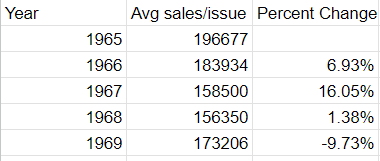
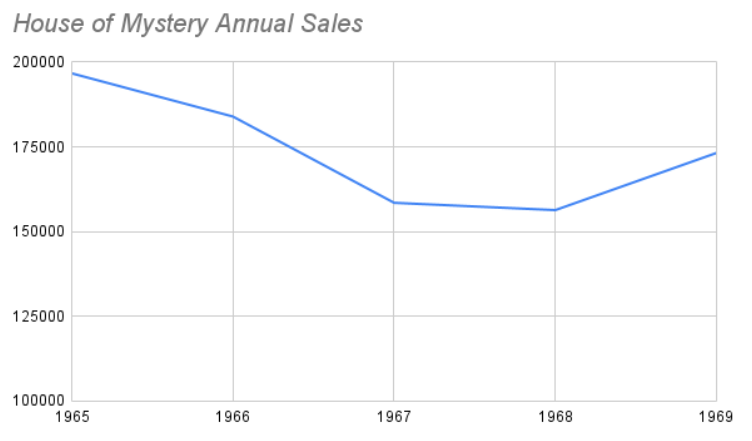
Because House of Mystery was an anthology title, it is difficult to place the blame for sinking sales solely on one of the comics featured within it. However, given that Dial H for Hero was the headliner and was displayed on the cover of every single House of Mystery issue it contained a story in, one could still put more responsibility on Dial than the other comic included in each issue. As you can see in the graph, sales of House of Mystery did fall during Dial’s run, and rose again after it ended. The comic's ranking in the annual sales charts is similarly inconclusive. Its placement did improve significantly between 1977 and 1978, but the trend continued from 1978 to 1979, the latter year having no Dial stories in any volume. Because the data was taken over years, not months, it is difficult to come up with any conclusion that these numbers say about the comic’s popularity. I still can’t come to the conclusion that the first run of the comic was axed due only to low sales. There was zero indication that it was ending given to fans, and a fanmail address was provided up to the very last issue, so I wonder if some other sudden event was the reason for its cancellation, such as the author quitting. He is also unfortunately elusive regarding biographical data, so it is impossible to provide any real conclusion.
Dial H
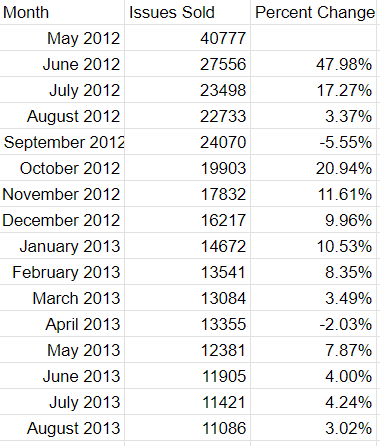
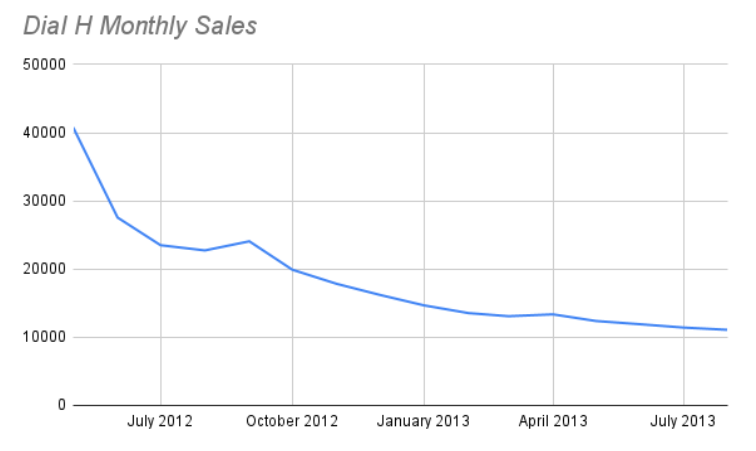
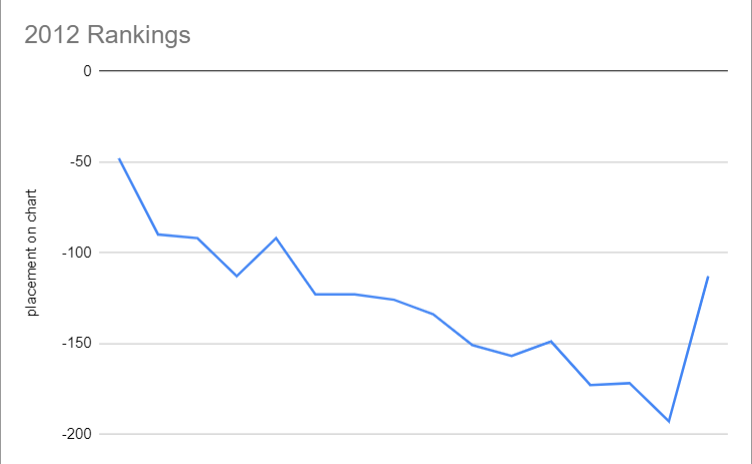
The first thing I noticed when plugging in the 21st century sales data into Google Sheets was just how much lower sales of comics were in general in the modern time period. It’s well documented that comic books sold significantly better in the Silver Age than they do now, but it was shocking to see the data sitting right in front of me. In this example, it is more clear to see the steady decline in sales from month to month. Though they eventually plateaued in the latter half of Dial H’s run, it is evident from the fact that the series was canceled halfway through that DC was not impressed by the numbers it was pulling. Looking at where Dial H placed in the rankings each month, a similar, though less conclusive pattern can be seen, with the ranking following a downward trend even if it occasionally rises a bit in individual months. Dial H was just one tiny part of DC Comics' New 52 initiative, in which every single one of their comics’ continuity was completely reset. Countless other new comics were brought back from the dead in the case of Dial H, or completely original. During this era, DC was taking a number of huge risks, even attempting to bring back non-superhero genre comics and less traditional heroes with new, edgy writing (such as bringing in China Miéville’s fantastically unorthodox style into their comics), and in hindsight it was clear that this was not the right move. In a retrospective published a decade after New 52, writers lamented management’s poor planning on the initiative (McMillan).
Dial H for Hero(2019)
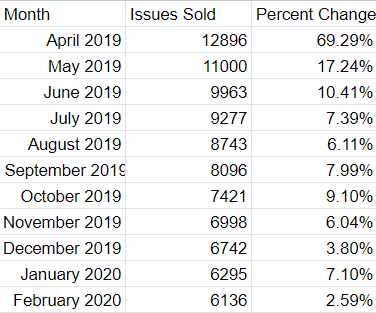
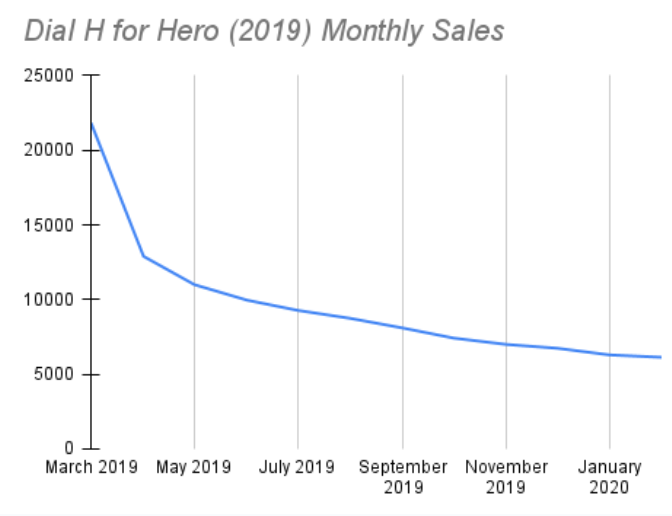
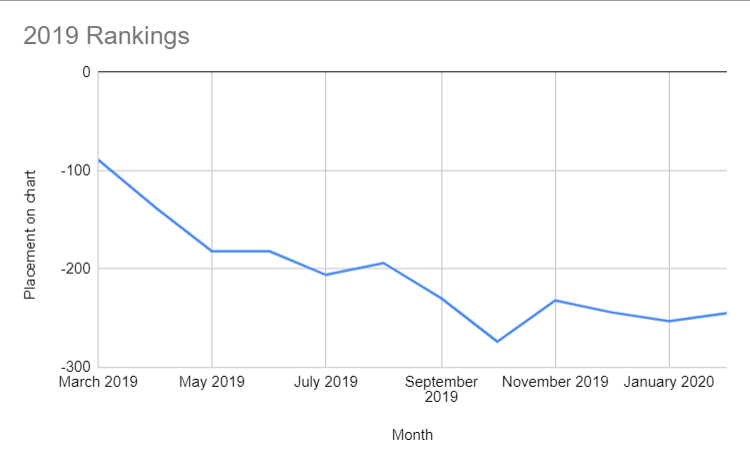
Since Dial H’s numbers were considered so disappointing, I was absolutely stunned to finally take a look at the 2019 reboot’s sales numbers and see that the sales of its first issue barely broke Dial H’s late-run plateau numbers. However, it is extremely important to note all of the caveats above when considering this data. As of my writing this, Dial H for Hero (2019) released just five years ago, at a time when digital distribution was at high levels of adoption and popularity. The invisible sales of digital and publisher-direct must have made up the difference here, because we know that DC was pleased enough with them to double the 6-issue limited series’ run to 12 issues. The data here proves that Dial(2019) did have long legs and fairly high retention rates compared to the 2012 run. Sales from the first issue to the last were cut by about half, which is significantly better than the previous run’s cut to about a fourth of issue one sales. Finding the rankings for this run also helped little. They seemed even lower than the rankings for the 2012 run, which must speak to the comic having made signigicant digital or trade paperback sales.
Ultimately, I think this data says a lot more about changing benchmarks for the comic book industry than it does about any one run of Dial H for Hero. Talking about digital sales and people waiting for trade paperbacks isn’t enough to account for the massive drop in sales between the 60’s and today. The truth is, comics just aren’t as popular as they once were-at least, not American comics books. Volumes of translated manga are now regularly hitting the New York Times bestseller list, especially for immensely popular action series such as Demon Slayer and Chainsaw Man, the latter of which could be compared to a superhero story in its narrative (though this is neither the time nor place to gush over Chainsaw Man, as much as I enjoy it). Even though American superhero films are still incredibly popular, I struggle to imagine a Dial H for Hero film performing very well. To be honest, I can’t imagine a scenario in which it would be anything more than a low(er) budget film with poor special effects, which would feed into its flop. Have I been led by the past into thinking Dial H would necessarily flop, or is the plot itself truly uninteresting? I don’t think it’s necessarily that it's uninteresting. The two writers of the reboots that I looked at did quite a bit in building new stories and worldbuilding off of the simple comic they drew the frame from. Perhaps some level of inviting the audience to participate is what's missing. All of the Dial stories are about average, non-superpowered people being given extrordinary abilities, so in theory including the audience in the writing process could be a good analogue to being a hero. This was actually done with the 1980's reboot of Dial H for Hero, which allowed readers to submit hero designs for a chance of being featured in the comic. It's a gap in my coverage of Dial H for Hero due to the scope it would take to add more comic runs to this project. I do hope that in writing this blog, you are inspired to check out any of the Dial H for Hero stories. I really think anyone will be able to find something they like out of it.